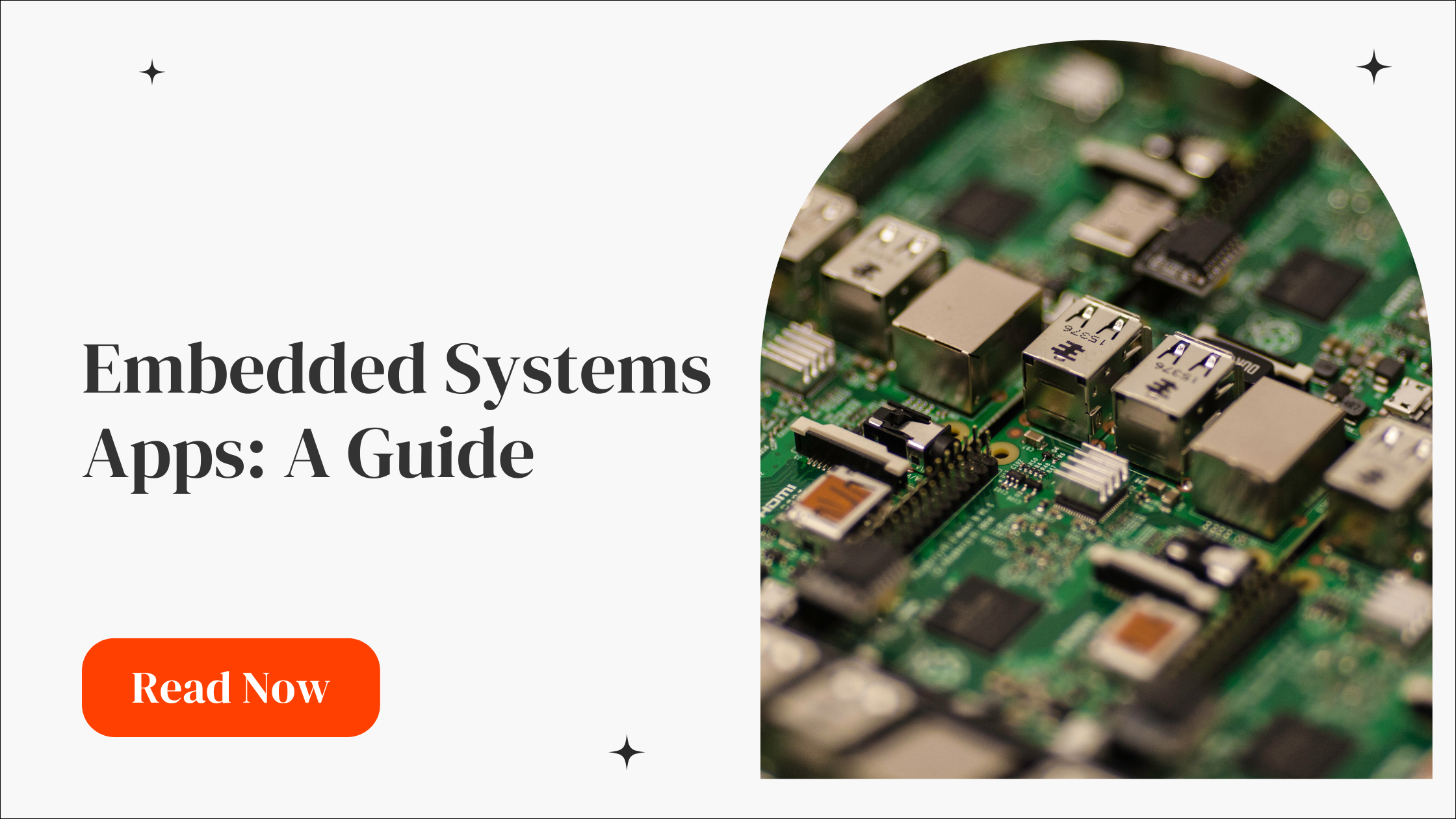
Embedded Systems Apps: A Guide
Discover what embedded systems are, their core hardware and software components, real-world applications, and how these apps impact product performance.
In this day and age, we're surrounded by embedded systems.
Toys, smartphones, cars, microwaves, elevators, even robotic arms in manufacturing lines — every piece of modern tech is an intricate interplay between hardware and software.
Embedded systems are the hidden engines that make these products work. And, over the years, they have evolved from performing simple tasks to augmenting or controlling bigger infrastructures with advanced features.
Read on to learn more about embedded systems, their components, and how they work.
What are Embedded Systems?
On a fundamental level, an embedded system is a combination of software and hardware built for a specific purpose (or purposes).
Most embedded systems are designed to run with minimal user interaction — receiving digital or analog input to compute and generate an output. Some, however, are designed with a user interface to enable real-time interactivity.
Regardless of the input design, embedded systems come with hardware and software components that directly affect the output.

It's worth noting that, unlike more complex and general-purpose devices like laptops, embedded systems are dedicated and highly purpose-built — be it for a single task or a set of similar tasks.
An automatic hand sanitizer dispenser, for example, uses embedded systems that detect signals from infrared sensors. When human hands are detected as the input, the embedded system triggers the output and activates the sanitizer's pump motor.
Embedded system cores live inside different types of Integrated Circuits (ICs), such as:
- Microcontrollers (MCUs) — Compact, consolidated ICs typically built as a single chip. They're often used in embedded systems for consumer electronics designed for specific functions, like smart thermostats, electronic toys, and remote controllers.
- Microprocessors (MPUs) — Powerful processing units that are built to perform more advanced computations, manage data flows, and execute complex instructions. Microprocessors often rely on external components, like memory units and other peripherals.
- System on a Chip (SoC) — ICs that are designed for both performance and efficiency — often used in products in compact and power-efficient form factors like smartphones and tablets. Unlike microprocessors, SoCs contain multiple components housed inside one chip, from signal converters to memory units.
- Field Programmable Gate Array (FPGA) — As the name suggests, an FPGA is an IC that's designed to be reprogrammable using a Hardware Description Language (HDL). This provides flexibility for embedded systems that require rapid or real-time processing, including industrial automation, telecommunications, automotive control, and other industrial sectors.
While the ICs above are predominantly used for embedded systems, other platforms are used depending on the nature and complexity of the tasks, as well as other factors like costs, power consumption requirements, and the presence of legacy systems.
This includes:
- Application-Specific Integrated Circuits (ASICs)
- Digital Signal Processors (DSPs)
- Programmable Logic Controllers (PLCs)
Components of Embedded Systems
Embedded systems consist of hardware and software components.
Here's a closer look at each component type:
Embedded Systems Hardware
- Input interfaces — Most embedded systems use hardware components to receive inputs. Common examples are sensors, buttons, scanners, and microphones.
- System core — Also called the processor, the system core is a specifically-built IC that runs the embedded system's logic and controls how inputs turn to outputs. As mentioned earlier, system cores can be baked into microcontrollers, microprocessors, ASICs, FPGAs, SoCs, and other platforms.
- Output hardware — The output device in an embedded system works to produce the response or action based on the processed signals from the system core. Some examples are actuators, Light Emitting Diode (LED) bulbs, relays, motors, speakers, and visual displays.
- Power supply — In the context of embedded systems, the power source comes in the form of a battery or Power Management Unit (PMU). They sometimes use advanced power management mechanisms, like sleep mode and real-time monitoring.
- Peripherals — Depending on the embedded system's configuration, additional peripherals may be required for specialized tasks. A few examples include signal converters (ADC and DAC), Inter-Integrated Circuit (I2C) interfaces, counters, and WiFi modules.
Aside from the hardware listed above, virtually all embedded systems include memory modules.
Different memory types store data differently and perform different functions.
Random Access Memory (RAM) handles temporary data such as operation variables, whereas Electrically Erasable Programmable Read-Only Memory (EEPROM) stores small amounts of persistent data.
In addition to these memory types, modern embedded systems primarily store data in their flash memory. This is a non-volatile memory type that's often used for embedded systems apps, firmware, and other bits of executable code.
This leads us to the software side of embedded systems, which is essentially the "brains".
Embedded Systems Software
- Firmware — Every modern embedded system, regardless of how lean or complex, will require some form of firmware to function. In most systems, the firmware pertains to low-level software for controlling basic hardware functions.
- Operating System (OS) — While all embedded systems have firmware, not all of them have an OS. Unlike firmware that only processes basic functions, an OS has more advanced capabilities like multitasking, task scheduling, resource management, file system management, and more.
- Device drivers — For multi-device systems, drivers enable embedded systems to communicate with peripherals. In a nutshell, drivers are software modules that translate instructions from the OS or firmware into low-level operations.
The combination of hardware and software components enables embedded systems to turn inputs into outputs — or, in other words, complete the specific tasks they're built for.
Examples of Modern Embedded Systems
In a world full of smart devices, anything that's a tad more advanced than your average toaster is most likely to be run by embedded systems.
Below are 10 of the most common use cases of embedded systems — some of which you may not be aware of:
1. Traffic Lights (Intelligent Transportation Systems)
You probably pass by hundreds of traffic lights in your daily commute.
Aside from controlling the color sequences, traffic lights also rely on embedded systems for advanced functions like vehicle detection and city-wide traffic management synchronization. Some modern traffic lights even use Internet of Things (IoT) infrastructures — tapping into sensor networks and online communication systems to adjust signal timings based on real-time traffic data.
2. Industrial Automation
The manufacturing space is all about efficiency, driving the rapid adoption of automation technologies.
Embedded systems make most of this automation possible.
Robotic assembly arms, for instance, rely on a cohesive network of embedded systems to achieve very high degrees of consistency, efficiency, and safety in manufacturing. These machines use a collection of sensors to track data like pressure, temperature, and proximity to humans with pinpoint precision.
3. Wearable Technologies
Smart watches and fitness trackers utilize embedded systems not just for timekeeping, but also for measuring and processing biometric data. Inputs are gathered through sensors like an accelerometer, gyroscope, GPS, heart rate sensor, and more before being processed by the firmware or embedded systems apps, which generate the outputs.
It's also worth noting that even non-smart electronic watches use embedded systems for functions like backlights, stopwatches, and other button inputs.
Tip: Looking for seasoned engineers to help with embedded software development? We can help you through the challenges of building the perfect software for embedded systems (contact us here).
4. Smartphones
Smartphones are undeniably one of the cornerstones of modern technology — impacting almost every aspect of people's day-to-day lives.
While smartphones themselves are not embedded systems, they rely on smaller systems for just about anything, from battery management to communicating with other IoT devices. These are often packaged as SoCs for better performance, power efficiency, and form factor.
Here are some examples of smartphone functions that run through embedded systems:
- Camera processing (Image Signal Processor)
- Audio processing (Digital Signal Processing)
- Sensors (accelerometer, gyroscope, proximity, ambient light, etc.)
- Communications (cellular, Wi-Fi, Bluetooth, etc.)
- Touchscreen controller
- Haptic feedback
5. Automotive
Just like smartphones, automobiles also rely on embedded systems for a vast range of functions.
Some are easily noticeable since they require human interaction (e.g., wipers, turn signals, horn, and infotainment system), while others complete essential functions under the hood, like:
- Engine Control Unit (ECU) — Uses sensors (i.e., oxygen) to optimize the operation of actuators, like spark plugs and fuel injectors.
- Anti-Lock Braking System (ABS) — Utilizes wheel speed sensor data to control hydraulic actuators, which prevents wheel lockups while braking.
- Telematics Control Unit (TCU) — A dedicated embedded system for data transmission and connectivity with services like GPS navigation, fleet management, emergency services, and diagnostics.
6. Smart Home and IoT
Embedded systems are the building blocks of smart home infrastructures and the IoT industry as a whole.
In non-technical terms, a smart home is a network of devices that are connected and can be remotely controlled, typically through a mobile app. Some examples are smart lighting, TVs, refrigerators, doorbells, security cameras, and air conditioning units.
To make this possible, smart homes rely on an orchestra of microcontrollers and SoCs — powered by an intricate layer of firmware, drivers, and embedded systems apps — to enable and streamline the interoperability of devices.
7. Consumer Electronics
With or without a smart home, most modern household electronics also use embedded systems for essential functions and Quality of Life (QoL) features.
Microwave ovens, for example, typically have at least one embedded system (i.e., control unit) for functions like temperature settings, timers, digital displays, and the magnetron.
Gaming products, like keyboards, headsets, and other peripherals, also frequently use embedded systems apps primarily for user customization. Using apps like the ROG Armoury Crate and Razer Synapse, users can easily control device functions like RGB lighting, sensitivity, sound enhancements, and cross-device synchronization.
What are Embedded Systems Apps?
Although software is a crucial component of embedded systems, not all of them have embedded systems apps.
Remember, embedded systems software usually comes in the form of simple dedicated programs — some with zero configurability. An embedded systems app comes into play if the product requires or supports advanced functions, including user interactivity, automated processes, and resource optimization.
Here are the top benefits of embedded systems apps from a consumer and developer standpoint:
- Maximize your product's functionality — If you're working on an embedded system, investing in an external app could unlock opportunities to expand the functionality of your product beyond its primary purpose. Fitness trackers, for example, let users do more with the product's biometric data tracking capabilities — from setting personal goals to UI personalization.
- Reach new audiences — Embedded systems apps can function as an abstraction layer that simplifies advanced product features, making it accessible to a wider range of consumers. Smart thermostats, for instance, benefited from having a user-friendly interface to streamline complex tasks (e.g., adjusting humidity levels and configuring motion sensors), accelerating market adoption.
- Enhance the user experience — Finally, an embedded systems app can improve the user experience on multiple levels. Advanced power efficiency controls enhance reliability, customization features lower the barrier to entry, and seamless connectivity simplifies integration with broader ecosystems.
Looking for Embedded Systems Apps?
Need help building a cutting-edge embedded system?
Regardless of niche, we at Horizon Labs have the expertise and tools to help you through every stage of your journey.
Through close collaboration with your team, our engineers will design, validate, and build world-class firmware — plus, commit to ongoing fine-tuning to maximize performance.
Book a meeting here and let's talk!
Need Developers?
We help companies build ideas into apps their customers will love (without the engineering headaches).
















For Startups & Founders
We've been founders ourselves and know how valuable the right communities, tools, and network can be, especially when bootstrapped. Here are a few that we recommend.

Mistakes to Avoid When Building Your First Product
Learn the key mistakes founders make when building their first product—and how to avoid them for a faster, smoother launch.
Read more
The Rise of AI in Product Development: What Startups Need to Know
Learn how AI is transforming product development for startups. From MVPs to scaling, here’s what founders need to know in today’s AI-driven world.
Read more
No-Code vs. Custom Development: Which is Right for Your Startup?
Weighing no-code vs. custom development? Learn which is right for your startup depending on stage, budget, and product complexity.
Read more
What is Mixpanel?
Learn how Mixpanel helps startups track user behavior to improve products and accelerate growth with clear data-driven insights.
Read more
How Tawk.to Can Boost Your Startup’s Customer Support Game
Learn how Tawk.to can benefit startups by enhancing customer support and engagement. Perfect for early-stage founders!
Read more
Grow Your Startup With Anthropic's AI-Powered Tools
Discover how Anthropic's cutting-edge AI tools can accelerate your startup's success. Learn about their benefits and see why they can be trusted by startups.
Read more
What is Data-Driven VC?
Learn what a data-driven VC means and how such investors can benefit your startup’s growth and fundraising journey.
Read more
What is Blockchain?
A beginner-friendly guide on blockchain for startup founders, covering key concepts, benefits, challenges, and how to leverage it effectively.
Read more
What is Cybersecurity?
Learn cybersecurity basics tailored for startup founders. Understand key risks, best practices, and how to protect your startup from tech threats.
Read more
What is Seedcamp?
Learn what Seedcamp is, how its European seed fund and accelerator program work, and how founders can use its capital, mentorship, and network to scale their st
Read more
What is AngelList?
AngelList is a prime platform connecting startup founders to investors, talent, and resources to accelerate early-stage growth.
Read more
What is 500 Startups?
Learn what 500 Startups (now 500 Global) is, how its accelerator and seed fund work, and when founders should consider it—plus tips for early-stage startups.
Read more.png)